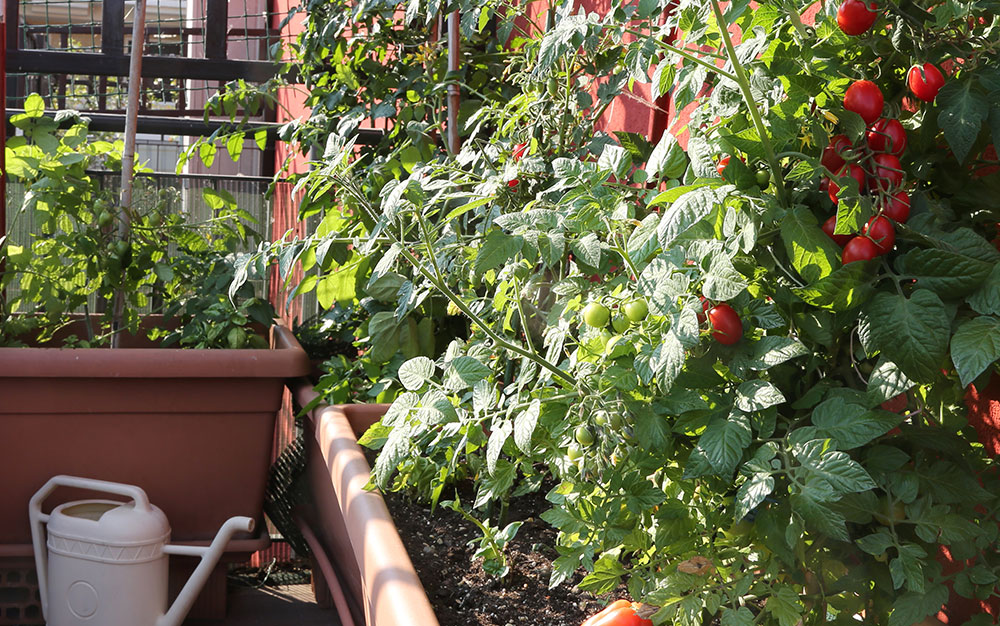Tomatoes are incredibly popular crops for gardeners. There are many varieties to try, from baby cherry tomatoes to huge fleshy beefsteaks. You can grow traditional tall cordon tomatoes, compact bush varieties or trailing types that suit hanging baskets.
Despite their popularity, tomatoes are not the easiest crop to grow. They need a regular watering schedule and quite a bit of care. But the taste of freshly picked tomatoes makes it all worthwhile! They grow and ripen best in a greenhouse, but you can grow them outdoors too.
How to look after me
Soil: Very rich, well-drained
Position: Sunny, sheltered
Location: Greenhouse, container, outdoors
Sowing
- Sow thinly in shallow pots or seed trays onto seed compost. Cover with a thin layer of compost
- Keep the compost moist. When seedlings have two true leaves, prick out to 9cm peat pots filled with seed compost
- Alternatively, sow a few seeds in 9cm peat pots filled with seed compost. Keep moist and remove the weaker seedling
- Water regularly to keep the compost evenly moist but without water-logging


Did You Know? The fruit of the tomato was once thought to be an aphrodisiac and was given the name ‘love apple’
Growing outdoors
- When the flowers of the first truss (fruiting stem that will bear the tomatoes) open, plant out to the final growing position
- For outdoor growing, plants will need to be acclimatised gradually – take the pots outside during the day and bring back in at night
- After a few weeks, plant out into final positions on very well-prepared soil. Space the plants 45 – 60cm apart
- Follow other growing instructions for greenhouse growing below
Growing in a Greenhouse
- When the flowers of the first truss open, plant out to the final growing position
- For greenhouse growing, put two plants in a growing bag or one per 23cm pot
- Cordon varieties will need to be loosely tied to an upright bamboo cane as they grow. Bush and trailing varieties do not need support
- Remove any side shoots on cordon varieties when the reach 2-3cm long
- Keep evenly watered and apply a balanced liquid fertiliser to the plants every 10-14 days until the first fruits start to set
- When the fruits appear, switch to a potassium-rich tomato liquid fertiliser and apply it every time you water
- Tomato plants in growing bags may need watering every day
- Once the plants reach the top of the greenhouse or have set seven separate trusses, or four trusses for outdoor plants, remove the growing tip of the main stem, at the point two leaves above the top truss
- When growing tomatoes indoors or under cover, it’s very important to adequately ventilate the plants by regularly opening doors and windows


Harvesting
- Start to harvest once the fruit is ripe and fully coloured
- At the end of the growing season, remove any stems with unripe fruits and place in a drawer with a banana. This helps to ripen them because bananas give off a ripening gas called ethylene
David’s Top Tip
Many of the problems with growing tomatoes come from irregular watering. Letting the soil dry out and then flooding it with water can cause fruits to swell, splitting the skin. Avoid this by sticking to a regular watering schedule.

Problems
Many people find that their seedlings all lean to one side of the tray – this is because they grow towards the sunlight. Rotate the seed tray every few days to stop this happening.
- Or build a DIY reflector – cut apart a cereal box and fold a panel to make a three-sided stand.
- Cover it in aluminium foil and stand around the seed tray. The sides should be at 45 degree angles.
Acclimatisation
- As they increase in size, the small plants will need moving into a larger pot.
- Then they can be gradually acclimatised to outdoor conditions.
- Do this by moving the pot outside during the day and bringing it back in at night.
- When all risk of frost has passed, you can transplant your plants into the garden.

TIP: Always handle seedlings by the leaves and not the stem, which is very fragile. If you damage a leaf, a new one will grow. If you damage the stem, the plant will die.

Leave A Comment